|

by Terry Collins
and Katie Pratt
December
10, 2018
from
DeepCarbon Website
Similar version in spanish
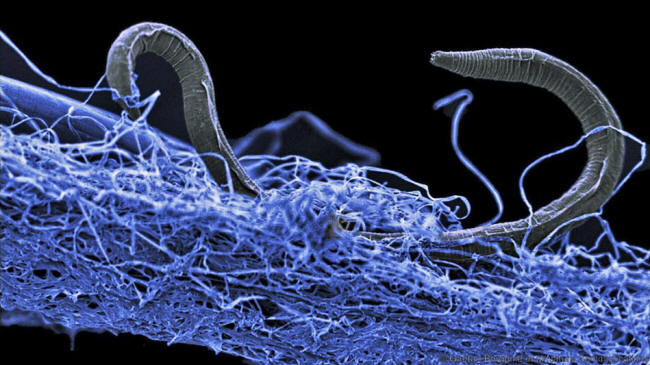
A
nematode (eukaryote) in a biofilm of microorganisms.
This unidentified nematode (Poikilolaimus sp.)
from Kopanang gold mine in South Africa,
lives 1.4 km below the surface.
Image courtesy of Gaetan Borgonie (Extreme Life Isyensya, Belgium).
See also...
Barely
living "zombie" bacteria and other forms of life
constitute an
immense amount of carbon deep within Earth's subsurface,
245 to 385 times
greater than the carbon mass
of all humans on
the surface, according to scientists
nearing the end
of a 10-year international collaboration
to reveal
Earth's innermost secrets.
Deep
Carbon Observatory collaborators, exploring the
'Galapagos of the deep,' add to what's known, unknown,
and unknowable about Earth's most pristine ecosystem.
Bacteria, archaea, and other microbes - some of them
'zombies' - exist even in deepest known subsurface, and
they're weirder than their surface counterparts.
~70% of Earth's bacteria and archaea live underground.
Earth's deep life suggests microbes might inhabit the
subsurface
of other planets.
Barely living "zombie" bacteria and other forms of life constitute
an immense amount of carbon deep within Earth's subsurface - 245 to
385 times greater than the carbon mass of all humans on the surface,
according to scientists nearing the end of a 10-year international
collaboration to reveal Earth's innermost secrets.
On the eve of the American Geophysical Union's annual meeting,
scientists with the
Deep Carbon Observatory today
reported several transformational discoveries, including how much
and what kinds of life exist in the deep subsurface under the
greatest extremes of pressure, temperature, and low energy and
nutrient availability.
Drilling 2.5 kilometers into the seafloor, and sampling microbes
from continental mines and boreholes more than 5 km deep, the team
has used the results to construct models of the ecosystem deep
within the planet.
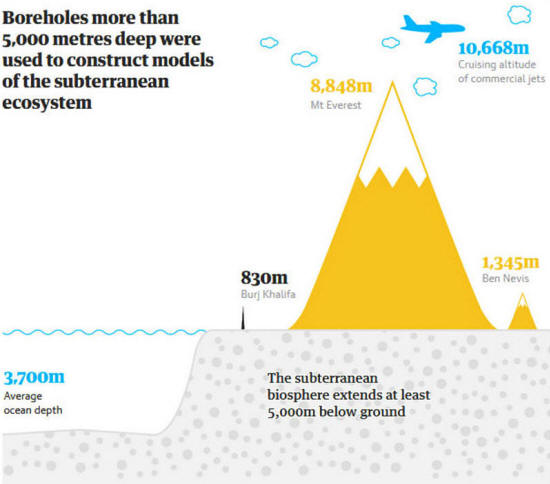
With insights from now hundreds of sites under the continents and
seas, they have approximated the size of the deep biosphere - 2 to
2.3 billion cubic km (almost twice the volume of all oceans) - as
well as the carbon mass of deep life:
15 to 23 [1]
billion tonnes (an average of at least 7.5 tonnes of carbon per
cu km subsurface).
[1]
- 15,000,000,000 to 23,000,000,000
The work also helps
determine types of extraterrestrial environments that could support
life.
Among many key discoveries and insights:
-
The deep
biosphere constitutes a world that can be viewed as a sort
of "subterranean Galapagos" and includes members of all
three domains of life: bacteria and archaea (microbes with
no membrane-bound nucleus), and eukarya (microbes or
multicellular organisms with cells that contain a nucleus as
well as membrane-bound organelles)
-
Two types of
microbes - bacteria and archaea - dominate Deep Earth. Among
them are millions of distinct types, most yet to be
discovered or characterized. This so-called microbial "dark
matter" dramatically expands our perspective on the tree of
life. Deep Life scientists say about 70% of Earth's bacteria
and archaea live in the subsurface
-
Deep microbes are
often very different from their surface cousins, with life
cycles on near-geologic timescales, dining in some cases on
nothing more than energy from rocks
-
The genetic
diversity of life below the surface is comparable to or
exceeds that above the surface
-
While subsurface
microbial communities differ greatly between environments,
certain genera and higher taxonomic groups are ubiquitous -
they appear planet-wide
-
Microbial
community richness relates to the age of marine sediments
where cells are found - suggesting that in older sediments,
food energy has declined over time, reducing the microbial
community
-
The absolute
limits of life on Earth in terms of temperature, pressure,
and energy availability have yet to be found. The records
continually get broken. A frontrunner for Earth's hottest
organism in the natural world is Geogemma barossii, a
single-celled organism thriving in hydrothermal vents on the
seafloor. Its cells, tiny microscopic spheres, grow and
replicate at 121 degrees Celsius (21 degrees hotter than the
boiling point of water)
-
Microbial life
can survive up to 122°C, the record achieved in a lab
culture (by comparison, the record-holding hottest place on
Earth's surface, in an uninhabited Iranian desert, is about
71°C - the temperature of well-done steak)
-
The record depth
at which life has been found in the continental subsurface
is approximately 5 km; the record in marine waters is 10.5
km from the ocean surface, a depth of extreme pressure; at
4000 meters depth, for example, the pressure is
approximately 400 times greater than at sea level
-
Scientists have a
better understanding of the impact on life in subsurface
locations manipulated by humans (e.g., fracked shales,
carbon capture and storage)
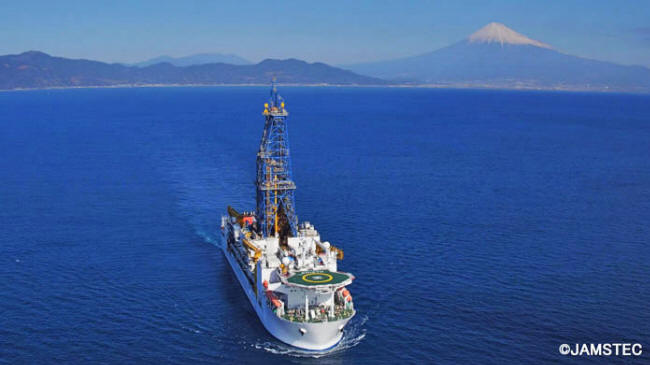
The Japanese scientific drilling vessel Chikyu
has made it possible for scientists to access
microbial life in the deep subsurface.
The ship is designed to ultimately drill 7 km beneath the seabed
in some of the planet’s most seismically-active regions.
DCO researchers were onboard the vessel for an expedition
to the Nankai Trough in 2016 to determine the
temperature and pressure limits of microbial life at temps above
120°C.
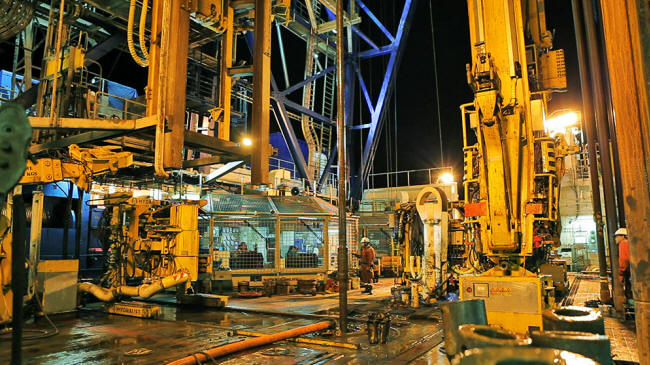
The D/V Chikyu is one of the most advanced
scientific drilling ships available today.
Coring operations take place 24 hours a day.
Image courtesy of Luc Riolon/JAMSTEC
Ever-increasing accuracy
and the declining cost of DNA sequencing, coupled with breakthroughs
in deep ocean drilling technologies (pioneered on the Japanese
scientific vessel Chikyu - above images - designed to ultimately drill far beneath
the seabed in some of the planet's most seismically-active regions)
made it possible for researchers to take their first detailed look
at the composition of the deep biosphere.
There are comparable efforts to drill ever deeper beneath
continental environments, using sampling devices that maintain
pressure to preserve microbial life (none thought to pose any threat
or benefit to human health).
To estimate the total mass of Earth's subcontinental deep life, for
example, the team compiled data on cell concentration and microbial
diversity from locations around the globe.
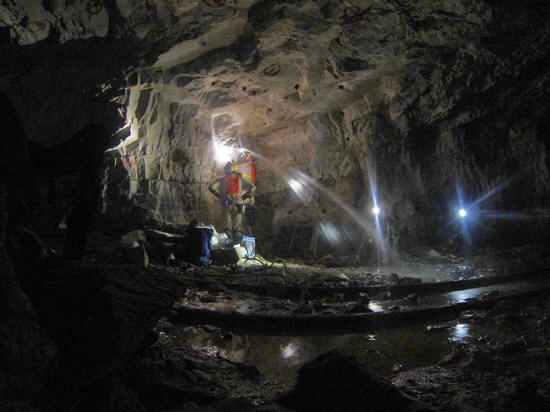
Cara Magnabosco and colleagues collect
ancient water samples 1.3 km deep within the
Beatrix Gold Mine, South Africa to investigate
the diversity and abundance of deep microbes.
Image courtesy of Gaetan Borgonie
(Extreme Life Isyensya, Belgium)
and Barbara Sherwood Lollar
(University of Toronto, Canada)
Led by Cara Magnabosco of the
Flatiron Institute Center
for Computational Biology, New York, the scientists factored in
a suite of considerations, including global heat flow, surface
temperature, depth and lithology - the physical characteristics of
rocks in each location - to estimate that the continental subsurface
hosts 2 to 6×1029 cells.
Combined with estimates of subsurface life under the oceans, total
global Deep Earth biomass is approximately 15 to 23 petagrams (15 to
23 billion tonnes) of carbon.
"Exploring the deep
subsurface is akin to exploring the Amazon rainforest. There is
life everywhere, and everywhere there's an awe-inspiring
abundance of unexpected and unusual organisms.
"Molecular studies
raise the likelihood that microbial dark matter is much more
diverse than what we currently know it to be, and the deepest
branching lineages challenge the three-domain concept introduced
by Carl Woese in 1977.
Perhaps we are
approaching a nexus where the earliest possible branching
patterns might be accessible through deep life investigation," says Mitch Sogin of the Marine Biological Laboratory Woods
Hole, USA, co-chair of DCO's Deep Life community of more than
300 researchers in 34 countries.
"Ten years ago, we knew far less about the physiologies of the
bacteria and microbes that dominate the subsurface biosphere,"
says Karen Lloyd, University of Tennessee at Knoxville, USA.
"Today, we know that,
in many places, they invest most of their energy to simply
maintaining their existence and little into growth, which is a
fascinating way to live.
"Today too, we know that subsurface life is common. Ten years
ago, we had sampled only a few sites - the kinds of places we'd
expect to find life.
Now, thanks to
ultra-deep sampling, we know we can find them pretty much
everywhere, albeit the sampling has obviously reached only an
infinitesimally tiny part of the deep biosphere."
"Our studies of deep biosphere microbes have produced much new
knowledge, but also a realization and far greater appreciation
of how much we have yet to learn about subsurface life," says
Rick Colwell, Oregon State University, USA.
"For example,
scientists do not yet know all the ways in which deep subsurface
life affects surface life and vice versa.
And, for now, we can
only marvel at the nature of the metabolisms that allow life to
survive under the extremely impoverished and forbidding
conditions for life in deep Earth."
Among the many remaining
enigmas of deep life on Earth:
Movement:
-
How does deep
life spread - laterally through cracks in rocks? Up, down?
-
How can deep life
be so similar in South Africa and Seattle, Washington?
-
Did they have
similar origins and were separated by plate tectonics, for
example?
-
Or do the
communities themselves move?
-
What roles do big
geological events (such as plate tectonics, earthquakes;
creation of large igneous provinces; meteoritic
bombardments) play in deep life movements?
Origins:
-
Did life start
deep in Earth (either within the crust, near hydrothermal
vents, or in subduction zones) then migrate up, toward the
sun?
-
Or did life start
in a warm little surface pond and migrate down?
-
How do subsurface
microbial zombies reproduce, or live without dividing for
millions to tens of millions of years?
Energy:
-
Is methane,
hydrogen, or natural radiation (from uranium and other
elements) the most important energy source for deep life?
-
Which sources of
deep energy are most important in different settings?
-
How do the
absence of nutrients, and extreme temperatures and pressure,
impact microbial distribution and diversity in the
subsurface?
Appendix
Selected Deep
Life papers
-
The
biomass and biodiversity of the continental subsurface.
(2018) Nature Geoscience Magnabosco C, Lin L-H,
Dong H, Bomberg M, Ghiorse W, Stan-Lotter H, Pedersen K,
Kieft TL, van Heerden E, Onstott TC
-
Global
distribution of microbial abundance and biomass in
subseafloor sediment.
(2012) PNAS Kallmeyer
J, Pockalny R, Adhikari RR, Smith DC, D'Hondt S
-
Exploring deep microbial life in coal-bearing sediment down
to ~2.5 km below the ocean floor.
(2015) Science Inagaki F, Hinrichs K-U, Kubo Y,
Bowles MW, Heuer VB, Hong W-L, Hoshino T, Ijiri A, Imachi H,
Ito M, Kaneko M, Lever MA, Lin Y-S, Methé BA, Morita S,
Morono Y, Tanikawa W, Bihan M, Bowden SA, Elvert M,
Glombitza C, Gross D, Harrington GJ, Hori T, Li K, Limmer D,
Liu C-H, Murayama M, Ohkouchi N, Ono S, Park Y-S, Phillips
SC, Prieto-Mollar X, Purkey M, Riedinger N, Sanada Y,
Sauvage J, Snyder G, Susilawati R, Takano Y, Tasumi E,
Terada T, Tomaru H, Trembath-Reichert E, Wang DT, Yamada Y
-
Dissolved organic matter compositions in 0.6–3.4 km deep
fracture waters, Kaapvaal Craton, South Africa.
(2018) Organic Geochemistry Kieft TL, Walters CC,
Higgins MB, Mennito AS, Clewett CFM, Heuer V, Pullin MJ,
Hendrickson S, van Heerden E, Sherwood Lollar B, Lau MCY,
Onstott TC
-
Phylogenetically novel uncultured microbial cells dominate
Earth microbiomes
(2018) mSystems Lloyd KG, Steen AD, Ladau J, Yin J,
Crosby L
-
A new
view of the tree of life
(2016) Nature Microbiology Hug LA, Baker BJ,
Anantharaman K, Brown CT, Probst AJ, Castelle CJ,
Butterfield CN, Hernsdorf AW, Amano Y, Ise K, Suzuki Y,
Dudek N, Relman DA, Finstad KM, Amundson R, Thomas BC,
Banfield JF
-
Survival
of the fewest: Microbial dormancy and maintenance in marine
sediments through deep time
(2018) Geobiology Bradley JA, Amend JP, LaRowe DE
-
Methyl-compound use and slow growth characterize microbial
life in 2-km-deep subseafloor coal and shale beds.
(2017) PNAS Trembath-Reichert E, Morono Y, Ijiri A,
Hoshino T, Dawson KS, Inagaki F, Orphan VJ
-
Nature
and extent of the deep biosphere.
(2013) Reviews in Mineralogy and Geochemistry, Volume
75, Carbon in Earth Colwell, F, D'Hondt S
-
High reactivity of deep biota under
anthropogenic CO2
injection into basalt. (2017) Nature Communications
Trias R, Ménez B, le Campion P, Zivanovic Y, Lecourt L,
Lecoeuvre A, Schmitt-Kopplin P, Uhl J, Gíslason SR,
Alfreðsson HA, Mesfin KG, Snæbjörnsdóttir SA, Aradóttir ES,
Gunnarsson I, Matter JM, Stute M, Oelkers EH, Gérard E
|






